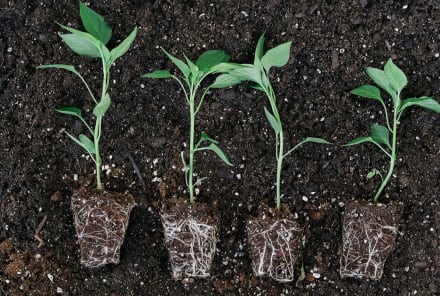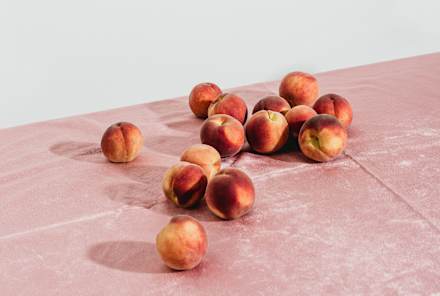Advertisement
How To Start Your Own Vermicomposting Bin (And Get Incredible Soil Out Of It)

Want to give your food scraps and organic waste a new life? Worms can help with that. If you can get over the initial shock of keeping worms as pets, vermicomposting is an amazing way to repurpose waste and turn trash into nutrient-dense soil. Here's everything you need to know about getting started with the technique.
What is vermicomposting?
Vermicomposting, also known as worm composting, is a type of composting that has worms eat natural material, such as vegetable and fruit peels, and then break them down through digestion.
Once the scraps pass through their system, they excrete it in what's known as worm castings. Before you get grossed out, know that those castings are a rich, nutrient-dense material that can turn soil into a paradise for plants. (It's often referred to as black gold!)
Here are the steps for vermicomposting:
- Buy a worm compost bin (or make your own using the process below)
- Purchase your worms
- Fill the worm's bin with a mix of food scraps and bedding
- Monitor your bin for odors or other signs of problems
- Loosen up the materials in your bin periodically
- Harvest your compost after 3-6 months
Vermicomposting vs. regular composting
Vermicomposting and composting are similar in the sense that their goal is to break down organic matter into a nutrient-rich soil amendment that you can add to your garden.
The differences lie in the amount of time the two processes take, how and where they're done, and what their end results are.
"One of the biggest advantages of vermicomposting is that worm compost often has a much higher nutrient content than traditional compost," adds Matt Eddleston, a gardener with over 20 years of experience and founder of Gardening Vibe.
Composting also requires more physical activity because you need to layer the compost pile and turn it often, about once a week. It usually needs to be done outside and can be difficult when the weather turns in colder months.
Vermicomposting has more flexibility when it comes to weather and space requirements. You can keep your worm bin anywhere where temperatures aren't too extreme, indoors or outdoors.
"You can do it indoors in an apartment, even when you don't have a lot of space," says Eddleston. "A worm bin fits easily in the corner of a room."
RELATED READ: 6 Best Worm Composters For Easy Vermicomposting At Home
Benefits of vermicomposting
It's sustainable.
Creating vermicompost is a way to repurpose organic waste instead of tossing it out. Food waste currently makes up nearly 25% of landfills in the U.S.1 (where it emits harmful greenhouse gases), so finding other uses for it is essential.
It makes great soil.
By returning food and plant scraps to the earth, you're creating a closed-loop system of organic nutrients, and the resulting natural fertilizer is super beneficial for plants and microorganisms.
It's a chemical-free fertilizer.
Chemical fertilizers or pesticides can be detrimental to soil health and wildlife. Worm castings are a safe and natural way to revitalize areas where soil has been overused or lost nutrients.
You can either buy a pre-constructed vermicompost bin or make your own using the following easy and inexpensive technique.
What you'll need to make a worm bin
- 2 dark-colored plastic containers or bins that are at least 12 inches deep (they shouldn't be clear, as worms are sensitive to light) and one lid
- Drill
- Small ceramic pot or brick
- Bedding (shredded paper, cardboard, straw, hay, dry leaves, dirt, or wood chips)
- Your worm of choice
Putting your bin together
- Using a drill bit between 3/32" to 3/16", drill 15 to 20 holes around the upper sides of one bin. These will give your worms air. Then, drill 15 to 20 holes in the bottom of that bin. These are there to drain any excess moisture that might build up.
- Place a small ceramic pot or brick on the bottom of your other bin. Then, stack the bin with air holes inside this bin. The pot or brick will ensure that there's space for the waste to collect. However, there shouldn't be much space between the sides of your bins, as you don't want your worms escaping! The whole operation should be airtight.
- Cover the top bin with a lid.
- Place 4 to 6 inches of bedding in that top bin. Once you put in your bedding materials, you can add your worms, which will burrow their way down into the bedding. "The bedding will help control high levels of moisture and provide protection against extremes while adding vital air for your worms," explains Randaci.
- From there, you're ready to feed!
Choosing your worms
Although it may be tempting to dig around in your backyard and look for worms yourself, not all worm species are suitable for composting.
"Purchase the appropriate species from a supplier for your area rather than collect worms from your yard," Angelo Randaci, Earth's Ally master gardener and horticulture expert, suggests. Yes, worm suppliers exist!
The type of worm you buy from them will largely depend on your climate, but here are a few good options to look into:
Red wigglers (can survive in most climates)
Red wigglers are one of the most popular worms for vermicomposting. "Because they are tolerant of a wide range of temperatures, they are a good choice for many parts of the country," says Randaci.
European nightcrawler worms (prefer cooler climates)
If you live in a colder region, you may want to go with European nightcrawler worms. "They prefer cooler temperatures and are found slightly deeper in the soil," he says, adding that "they reproduce more slowly than the red wiggler worms but produce greater biomass (finished material)," he adds.
Indian blue worms & African nightcrawlers (prefer warmer climates)
You can also look into Indian blue worms and African nightcrawlers "but they are better suited to tropical environments," says Randaci.
If you're wondering if it's possible to combine different worm species in one bin, the quick answer is yes—but there can be caveats. According to Randaci, over time one type of worm may dominate. "If conditions are better for one species than another, that species will multiply faster," he says.
Feeding the worms & maintaining the bin
To get the process started, all you need to do is fill the worm's bin with a mix of food scraps (green and brown) and "bedding" such as shredded paper, cardboard, straw, hay, dry leaves, dirt, or wood chips.
Feeding worms is one of the most important parts of the process, but you'll need to pay attention to what and how much you're offering them.
Worms can eat a variety of organic materials including fruit and vegetable scraps, coffee grounds, and tea bags. But you'll want to avoid citrus fruits and peels since they're acidic and worms have a difficult time digesting them. You shouldn't add any animal or dairy products to the bin, either.
In addition to food waste, your worms will also eat their bedding. "Your worm bedding is also food for worms. You want to have a higher content of bedding than food waste," says Randaci.
When you buy your worms, you should get information on how much they eat. Follow it closely; the key to maintaining your bed is making sure it has the right amount of food (and therefore, moisture) at all times. When the system is out of balance, you'll be able to tell pretty quickly.
"If you overfeed [the worms], then the excess will rot, causing a bad smell," explains Eddleston. "Rotting and heat buildup can occur and even kill the worms," adds Randaci.
Moisture can also build when you overfeed. According to Randaci, "You add moisture every time you add food waste because of the high water (80% or more) content of the vegetable."
If you notice that food isn't being eaten by the worms or the bin has a bad odor, you'll want to hold off on adding more scraps.
Tips & tricks
Here, Randaci and Eddleston share their top tips for anyone who's just getting started with vermicomposting:
- Lightly loosen up the materials in your bin periodically with a small hand rake to add air to the bin. This will help prevent odors in your bin and provide your worms with air (which, interestingly enough, they breathe through their skin!).
- Place your bin out of direct sunlight, as the heat from the sun can dry out your worms' all-important skin. Dark areas like garages or basements tend to be best for them.
- During cold months, place your bin in the warmest area of your garage or basement. Maintain high levels of bedding for added protection from extreme temperatures.
- Feed the worms in different areas of the bin each time. This prevents the worm population from growing too concentrated in one particular area.
- If you notice the smell of ammonia, anaerobic decomposition is taking place in the bin. This indicates that the environment is too wet, and your soil may even be waterlogged, which can result in your worms dying. It's a good idea at this point to drain that bottom bin, add new dry bedding, and stir the contents of the bin to introduce more oxygen.
Frequently Asked Questions
How often should I feed the worms?
"Once a week is usually enough," says Eddleston. In between, "make sure you check that they're eating what you give them."
What are the signs of too much moisture?
Signs of too much moisture in a worm bin are the presence of fruit flies/fungus gnats, foul odors, or leached liquid from your bin, says Randaci.
Can I do a test to check the moisture?
"One way to determine moisture in your bin is to take a handful of your bin material and squeeze it," says Randaci. "If water comes out, your bin is too wet." Once you know your bin has too much water and moisture, "add more dry bedding to absorb some of the moisture."
Is it bad to have mold in the bin?
"A small amount of mold is fairly normal and isn't anything to be concerned about," says Eddleston. "But excess mold can be a sign of other problems, such as overfeeding."
Can I vermicompost year-round?
You can worm compost as long as the temperatures aren't too cold for the worms. "At temperatures below 60 degrees, compost production slows," says Randaci. "Temperatures below 40 degrees may kill your worms."
What should I do if there are fruit flies?
Fruit flies can become an issue with excess or rotting food. "Because fruit flies are attracted to fermenting fruit and vegetables, you want to prevent the conditions inside the worm bin from becoming too moist and anaerobic," says Eddleston.
He suggests keeping enough bedding in the bin to make it easy to bury the food waste. "Don't drop the scraps on the surface," he says. "Instead, clear a space to put them in. Then cover them well with dirt and moist paper."
How long until you can harvest the compost?
"Harvest in three to six months, depending on how many worms you have, how much they multiply, and the kinds of food within your bin," says Randaci. "Speed up the process by cutting up scraps into smaller pieces an inch or so in size."
The takeaway
While it does take some trial and error, starting a vermicompost bin is a rewarding way to watch nature at work and become more involved in your environment. Equipped with this know-how, you'll be harvesting your own black gold in no time that you can add to your productive garden.











